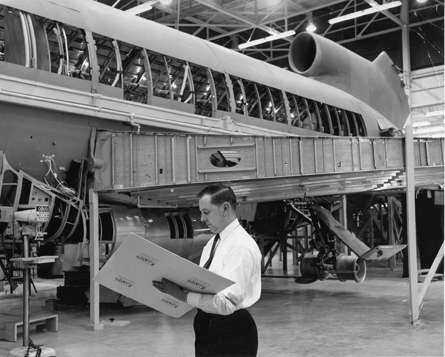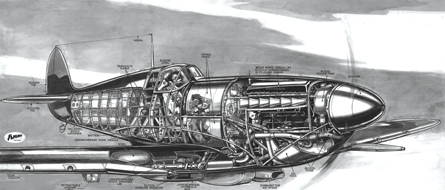By Giuseppe Picarella
For a little over 100 years the aerospace industry has continually pushed the boundaries of engineering knowledge, stretching both the abilities of the engineers involved and challenged each generation of Flight's readership. Shadowing these developments, clarifying and interpreting the intricate nature of the subject matter has been the job of Flight's cutaway and editorial art department.
Flight's early technical artwork provided as much information as the supporting editorial text, detailing specific assemblies, construction techniques and even the types of knots employed. This was invaluable information to the increasing number of aeronauts intent on building their own flying machines. As aircraft became increasingly larger and more complicated, so too did the detailed artwork and by the early 1930s the first complete cutaways as we know them today appeared under the leadership of Max Millar, who became head of our then-publisher Iliffe Press's artists' department in 1920. Max set down the general rules that we adhere to today: information, clarity and accuracy.
 |
|---|
| Arthur Bowbeer sketching at the Boeing factory in the early 1960s |
Our cutaway output reached a peak during the post-war period, mirroring the frantic pace of the world's aerospace industries and technological breakthroughs. During this period the number of cutaway artists available to Flight from the artist department was also at an all-time high with over a dozen very capable artists available. Among them Frank Munger, Arthur Bowbeer and John Marsden are perhaps the most well known, responsible for collectively producing several hundred cutaways between 1946 and 1994.
US DOOR OPENS
Bill Gunston, Flight's technical editor in the 1950s and 1960s, recalls how a visit to the US West Coast in June 1955 opened the door for a raft of Flight cutaways of US airliners. "I attended the Fifth Aeronautical Conference in Los Angeles that the Royal Aeronautical Society helped organise," says Gunston. "Afterwards I visited 21 aircraft and engine companies on the US West and East coasts. These meetings paved the way for Arthur Bowbeer to pay his own visits and produce the first detailed cutaways of the Douglas DC-7C and DC-8, Boeing 707-120, and Lockheed L-1649 and Electra, for our special Commercial Aircraft issue of 6 July 1956."
 |
|---|
Max Millar's cutaway captured the grace and power of Supermarine's classic Second World War fighter, the Spitfire |
The only real departure from the fully "endorsed" Flight cutaways appeared in the form of handful of "probes" produced during the 1950 and 1960s. With the Cold War in full swing, many of the "black" projects were strictly out of bounds, especially in the USA. The artists began collecting any and all information on specific projects, such as the Boeing B-52 and Lockheed F-104. Every photograph, press release and advertisement found in the world's aviation press was studied and filed away until it was deemed that enough information was available for a probe to be completed. Some unfriendly noises were heard from the US Air Force and Royal Air Force of the day and Flight's cutaways were even mentioned in the House of Commons and, it is said, the US Senate.
The year 1995 would introduce possibly the two largest changes to Flight's artwork in a generation - the move to electronic editorial artwork and the introduction of cutaway posters.
NECESSARY TRANSITION
Electronic editorial artwork was a necessary transition at the time, allowing the art department to produce colour artwork in-house before placing it directly into the magazine. The move to the poster format would also have far-reaching affects for the cutaways, finally giving them the gravitas needed to escape from the traditional double page spread, allowing the manufacturers and the readers to fully appreciate illustrations.
At around the same time the emergence of computer-aided design systems within the aerospace industry brought changes to the collection of engineering material. Gone were vast amounts of paper accumulated through days of collecting hundreds of two-dimensional engineering drawings. Now three-dimensional images were available to the cutaway artists, although the accompanying amount of legal paperwork, proprietary information, nondisclosure and international arms trade documentation meant the amount of paper was virtually the same.
 |
|---|
Flight's Concorde cutaway |
The new poster format would ultimately allow Flight's cutaways to move into full colour and, after several months of trials, the first electronically finished, full-colour cutaway (the Beech Mk-II) was published in 1996. This move brought many new challenges to the department, not least being the increase in production time, but the finished cutaways were now of such high quality that they could be printed up to 6m-plus (20ft-plus) wide. While manufacturers quickly embraced the colour cutaways, the reduction in output caught many of them off guard and would see cutaway waiting lists appear.
FACTORY VISITS
Today Flight's cutaways are internationally recognised and as unique as ever, with only two cutaway artists and one editorial artist fulfilling the needs of the magazine. Fifty years ago Flight's artist's wandered production lines, pencil and board in hand, staying at the factory until the pencil drawing was completed. While time and money are now major issues, today's cutaways are still fully supported by the manufacturers, with visits and full access to the engineering material. They are editorially unbiased illustrations, a fact appreciated by the manufacturers.
The output of Flight International's cutaway team (and its absorbed collection of The Aeroplane cutaways) totals over 1,200 to date and the unique approach to in-house, self-monitoring cutaway artwork is still as important as it was in the first days of the magazine. The real value of the cutaway collection grows year on year as engineers, historians and enthusiasts increasingly appreciate these truly contemporary illustrations, having been produced with access to the actual aircraft on the actual production line.
If Max Millar were still around, I think that he would see that his old department is still providing clarity and understanding to an ever-changing industry and audience.
Giuseppe Picarella joined Flight International in 1994 and was appointed senior technical artist in 2001
Source: Flight International













